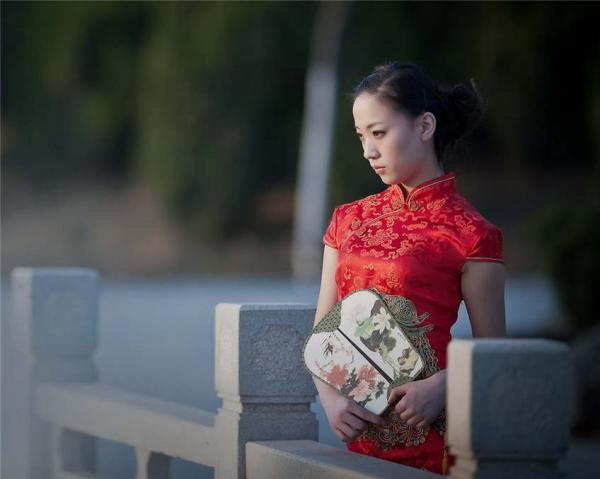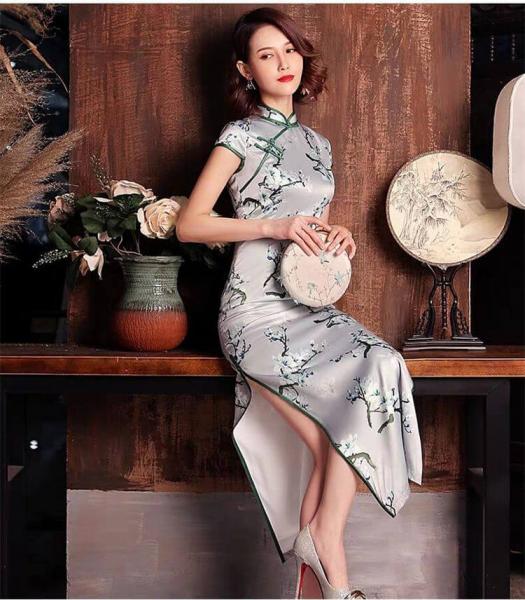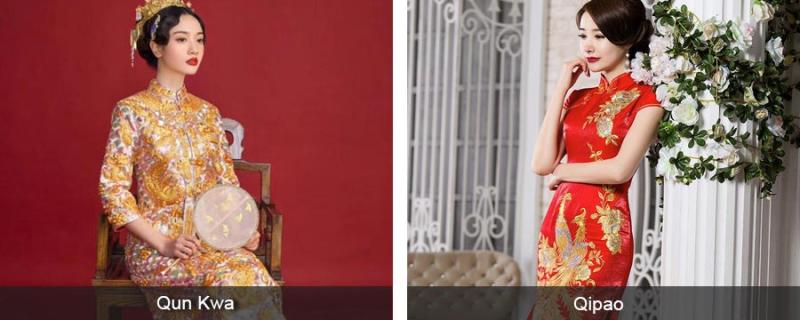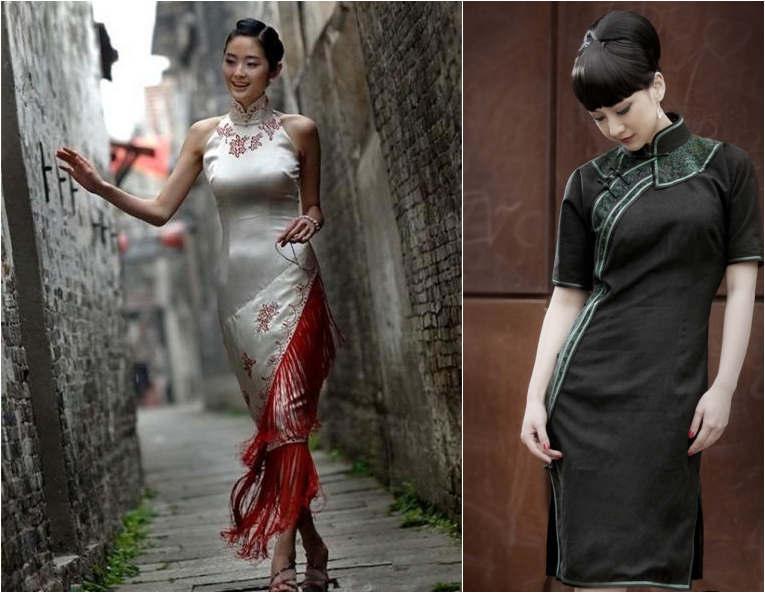Cheongsam (Qi-pao) - the Most Beautiful Traditional Chinese Dress
If Hanfu is the representative of the revival of traditional Chinese clothes culture nowadays, the cheongsam/Qipao is the benchmark of Chinese beauty for all girls. Derived from the traditional Manchu cheongsam, the qipao dress is a traditional fashion that emerged in the Republic of China era.
How beautiful it is? Qipao features elegant design, exquisite craftsmanship and patterns with a distinguished Oriental charm. The ingenious cutting showcases the unique dignity and grace of Eastern women, and the meticulous hand embroidery further highlights the magnificence and nobility of the cheongsam.
What is Cheongsam/Qipao
How to define Cheongsam/Qipao? The Cheongsam or "Qi Pao" is a classic female costume which many westerns associated with Chinese women. It features at stand / high neck, loose chest, fitted waist, sides opening and varied sleeves (short, medium or full length) with tradition Chinese patterns. It is comfortable to wear and can fully set off the soft and female elegant figure, which gains growing popularity in the international fashion.

Legend of Cheongsam
A young fisherwoman at Jinbo Lake improved her long and loose fitting dress to a long multi-looped-button gown with slits to better convenient herself during work. She lived her life at the lake side until one day a fortune befell on her.
The young emperor of China at that time dream about his gone father one night, and his father told him the lady at the Jinbo Lake with self-made cheongsam would be his wives. The emperor sent his man out and found that clever young fisherwomen. She became the queen and Cheongsam spread among Manchu women.
Cheongsam through the years
Although it is a fork tale, the Cheongsam was really from the Manchus of Qing Dynasty. When they ruled China, their "banner gown (also translated as Qi-pao), a collarless, Tube-shaped gown wore by both men and women was developed, which was the origin of Cheonogsam. It was long and embroidered, with broad lace trimmed at the collar, sleeves and edges.
Qing Dynasty collapsed at early 20th century; women began to enjoy more freedom and improved their clothing for more comfort and freedom at movements. Instead of adopting western dress styles, they made changes to Qi-pao, cuffs narrower, lace trimmed thinner, varied collars and length, and tailored to be more fitting and revealing.
Qipao came to popular within the whole China. Its extraordinary popularity occurred at Shanghai, with its slimness and fitness, regarding as a formal suite for important occasions and social activities. But this prosperity was only existed at 1920s-1949.
A new boom appeared since 1990s, many ladies show warm welcome to this elegant and classic Asian gown. Cheongsam elements are used in world fashion industry to make it more charm over the world. Some Chinese girls even take red Cheongsam as bridal dress today, to add more beauty and elegant on wedding day; it is also common in some Chinese hotel and restaurant, hostess wear traditional qi pao to welcome or serve customers.
The Chinese cheongsam in the 21st century has transformed into a source of inspiration for global fashion. The haute couture designs of luxury brands incorporate elements of cheongsams. Chinese and foreign celebrities appeared on the star-studded red carpet wearing cheongsams. The British Museum and the MET Gala exhibited exquisite antique cheongsams. Overseas, orders for custom-made cheongsams on Etsy and Amazon have soared, making it one of the top things to buy in China.

Cheongsam/Qipao Materials and Colors
Traditional high-end fabrics include silk (suitable for wedding cheongsams), satin, gauze (suitable for summer), and velvet (suitable for winter). Modern daily practical fabrics include cotton and linen, chiffon, acetate, and denim.
Classic traditional color cheongsams include pure red cheongsams, royal blue cheongsams, dark green cheongsams, and champagne gold cheongsams.
Qipao Are Available in a Myriad of Styles and Patterns
Straight front style
The most common style of Chinese cheongsam. The line on the front lapel is relatively straight, and there is a right Angle on the lapel.
A cheongsam with a slanted collar
This style features a connection that slides directly from the neckline to the chest, and then a loop is added along the edge. The lines of this qipao dress are relatively smooth.
Ruyi lapel
The front of the garment on the chest will be decorated with auspicious patterns, presenting a classical beauty. This kind of cheongsam dress is mostly seen on important occasions, such as weddings and attending ceremonies.
Modern Cheongsam
Vintage Qipao: It is fitted cut, wuth high collar, buttons, and slit design, emphasizing the feminine curves. Both long sleeves and short sleeves are acceptable.
Improved daily cheongsam: Loose cut, with lowered neckline, shortened hem, it increase comfort, and suitable for daily wear.
New Chinese-style cheongsam: Combining Western tailoring and integrating modern elements, it is suitable for young girls who like the traditional Chinese clothing style.
Chinese Cheongsam Wedding Dress
One of the Must-haves for Bride in China, the cheongsam is an excellent choice for the bride's wedding dress and toasting attire in Chinese weddings today. The Chinese wedding gown is usually a dragon and phoenix cheongsam, with auspicious patterns such as dragons, phoenixes and peonies embroidered with gold and silver threads, symbolizing "good fortune brought by dragons and phoenixes". The fabric is generally heavy silk satin with hand embroidery, and some are decorated with sequins and bright diamonds.
The Qipao dress for toasting is usually fitted, short or knee-length, making it convenient to walk around for toasting. Festive colors such as bright red and champagne gold are used. The materials are usually multi-dimensional lace patchwork, tassels, pearl buckles, with other exquisite decorations.
>> Related reading: Wedding Customs and Traditions in China

Where to Buy & Customize Qipao
In Shanghai
Li Gu Long (丽古龙) - Located at 205 Changle Road, this high-end Shanghai cheongsam couturier has made a name for itself for having created cheongsams for a number of Chinese celebrities. It specializes in unique designs and handmade qipao.
Feng He Xiang (凤和祥) - Located on the South Bund, No. 399 Lujiabang Road, this store created Chinese dresses for the 2001 Shanghai APEC conference. The store's masters have more than 40 years of experience in making handmade cheongsams.
Jinzhi Yuye (金枝玉叶) - A customized store specializing in traditional and improved qipao. Inspired by the international fashion world, the shop skillfully integrates fashion elements into cheongsam designs.
>> Recommended 4-day Shanghai Tour for Women to tailor make yourself a Qipao dress
In Suzhou
Not far from Shanghai, Suzhou is famous for its water towns (such as Tongli Water Town) and classic Suzhou gardens (such as the Humble Administrator's Garden), , and Suzhou embroidery. It is also a great producer of Chinese Silk. Suzhou cheongsams are characterized by their beauty and elegance.
The fabrics are selected high-quality soft satin and crepe satin. The embroidery patterns are also rich and varied, such as moonflower, peony, phoenix, plum, orchid, bamboo, chrysanthemum and so on.
In 1989, a pink qipao with peacock pattern designed and embroidered by the Suzhou Embroidery Factory won a gold medal at the first Beijing International Exposition. Famous local qipao shops in Suzhou include Jiangnan Rhyme (江南韵), Butterfly Dance Fragrant Clothing(蝶舞香衣)and Jinying Garment (金英制衣).
In Beijing
The Beijing-style qipao is a traditional dress-making technique that originated in the early Qing Dynasty. It is characterized by thick fabrics such as brocade and satin paired with wide-edge decorations, presenting a dignified and elegant style. Its core craftsmanship includes coiled flower buttons, slanted lapel design, and high slit cutting, etc.
If you want to customize a qipao on your Beijing tour, some popular stores with locals are Red Hall Cheongsams (红馆旗袍), located in Wudaoying Hutong - customization takes about 40 days. Rui Fu Xiang (瑞蚨祥), located in Dazhalan. Prices range from 3,800-6,000 RMB. You can get it customized in about 7 days.
>> Tailor make a China tour to visit explore the best of China and customize your own Qipao

Tips for Qipao Dress
1. Due to the particularity of different ladies' figure, avoid ready-made qipao, but try to custom one according to your chest, wrist and so on.
2. There are diversified materials for making Cheongsam. Choose silk and other cool and soft material at summer; while velour or brocade for spring and summer.
3. Most Cheongsams are not suitable for home cleaning, do it at wash house. Oil, lipstick and soft drink on your qi-pao would cause big problems when washing.
4. Never wear a Qi-pao lasting for several days.
5. Away from keen-edged objects, they can scratch your qipao.
6. Never curl up your sleeves when wearing Cheongsam.
7. For a common dirty on a Qipao, cover the dirty with tiny wet cloth and use a electric iron to have it cleaned.
8. Hung the Cheongsam with clothes rack, make sure it smooth and in good condition.